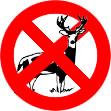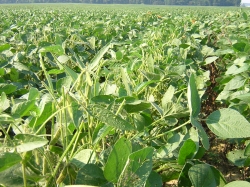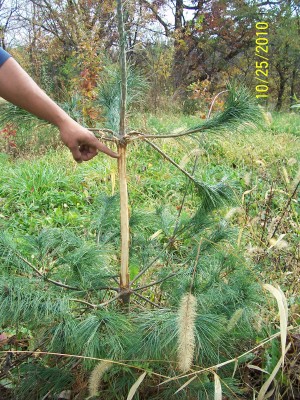Stop the Deer Damage
Restoring the environment - Protecting our property - Saving lives
Oak tree severely browsed by deer, I planted this tree 12 years ago, (it should be 25 ft tall). There were many rows of these oaks but most have starved to death with the constant eating of the leaves and branches by deer.
Deer Habits and Damage
Whitetail deer are present throughout the USA and in all areas over populate the carrying capacity of the land according to an Iowa DNR study, and have been deemed the most dangerous animal in Iowa. Fawns born in the spring can be ready to breed in the fall, with most year old adult female deer producing twins in the following spring. DNR officials have stated that deer can jump over an eight ft tall fence. Deer numbers can increase over 40% every year if few predators are present according to the Iowa DNR.
Deer herd up in the winter time where cover is available, and can destroy large areas of habitat, and private property, when they run out of food they travel in great herds to new areas and destroy more property. In the spring time they spread out over the countryside with more cover being available. Tracking devices used on deer have shown them to move up to 20 miles in 24 hours.
Iowa DNR study of 1998
White pine tree destroyed by deer rubbing horns on tree.
The Iowa DNR did a study published in the journal of Iowa academic science in 1998. They showed that once deer number are more than one deer per 65 acres of deer habitat, (agriculture land is zero deer) forest health begins to decline. The number of tree seedlings, species of birds and groundcover of wildflowers begin to decline. The study showed that deer numbers of over 1 deer per 65 acres are destroyers of our natural environment, and private property. In many areas (state parks) and private property, have 10-100 times this amount on the land. In 2019 I shot 45 deer between May and Nov. on an area of about 80 acres, this comes to a average of 360 deer per square mile. If I have not taken action nothing would have grown there except for grass, weeds and thorn trees. Here is a link to the National Park Service on the effects of deer on their environments. https://www.nps.gov/cuva/planyourvisit/upload/Deer-SB_72013-final-update.pdf Yellowstone park introduced wolves to help control over populations of deer and elk and there results have been dramatic.
The Iowa DNR manages over 485,000 acres of State and Federal land for deer. In these areas there is little to no regeneration of native species, due to deer overpopulations. Interesting article: Deer are consuming the world's largest organism, killing off its opportunity for growth
X-mas tree farm destroyed by deer eating them.
New research has now shown that there should now only be one deer per 100 acres of deer/tree habitat to preserve the native environment. If you want wildlife habitat and the most species of wildlife on your property the best thing you can do is to reduce the number of deer on your property to no more than one deer per 100 acres .
Click here to see article about deer eating and destroying 12,000 Christmas trees in less than a week. See pictures left >
Walnut tree top eaten off by deer.
Deer will eat anything! Iowa wildlife extension specialists stated deer will eat over 350 species of plants. Deer eat browse (leaves, twigs, shoots of woody plants and vines) and forbs (weeds and other broadleaf flowering plants), but one of their favorite is young agricultural crops when in season. (Click here to see list) They do eat some grass, but only when it is young, green, and succulent. They love acorns, fruits, nut crops and berries, and I have seen them break the branches off fruit trees to get at the fruit. Sheep and goats are in the same family of animals as deer and cause severe damage to the environment in many parts of the world. Deer food shortages can occur especially in the winter months One Deer can eat 7-10 lbs of food a day according to the Iowa DNR, and that is over 2500 lbs per year per deer, almost as much as a cow eats.
Deer — who are considered “selective foragers” because they avoid alien invasive species — over browse on native vegetation faster than it can regenerate. When a forest loses undergrowth, it loses critical places for small animals and birds to shelter and nest. When over browsing alters under story light conditions, the increased light levels allow alien invasive species to flourish while suppressing shade-loving native woodland species.
"Sadly, I spend much of my time in ecological disaster zones—forests devastated by too many deer," says Thomas J. Rawinski, a U.S. Forest Service scientist in Durham, N.H. "I truly believe that this has become the single greatest conservation challenge of our time."
Deer feed at night
Deer move to their feeding areas at night and will eat and destroy your property. They can move over 1 mile in the evening, eat and rub your property, and retreat to there cover area to stay hidden and 'chew their cud ' during the day. Hunting rules never allow you to remove deer at night when they are the most destructive, we remove deer at night to Stop the Deer Damage.
Arborvitae eaten during the winter, destroying their windbreak. Imagine what would happen if you had small trees planted in a new windbreak and this happened. We stop this deer damage and protect our property. This happened in two nights.
Soybean tops eaten off, sometimes the whole plant
Browse: Tree leaves, bark and acorns, Hackberry, mulberry, sumac, hawthorns, poison ivy, American chestnut, wild cherry and plum, wild grape, honeysuckle, willow, dogwood, elm, blackberry and dewberry, acacias, walnut, including all trees species. Oak, Hackberry, mulberry, and willow leaves seem to be a favorite. In the winter all deciduous tree bark and evergreens can be eaten with White Pine and Arborvitae being their favorites.
Right—Winter damage to an arborvitae tree, the tree on the left is what it looked like before the deer ate it . The landowner sprayed the trees with deer repellent and heard that dryer sheets would keep the deer off the tree. Both did not work and on some they even pulled the sheet off to get the green foliage. When deer are hungry, they will eat anything and deer repellent will not help.
Oak Tree destroyed by buck deer rubbing in the fall.
Deer Diseases: Deer are effected by a multitude of diseases, some are fatal to humans and other animals. Bovine Tuberculosis and Encephalitis are prevalent in many states. Chronic Wasting Disease is in Iowa, Hemorrhagic blue Tongue and EHD has been detected in over 63 counties in Iowa, and has spread to cattle herds. Here is the current locations of CWD in Iowa from the Iowa DNR and is spreading rapidly: https://iowadnr.maps.arcgis.com/apps/MapSeries/index.html?appid=1de3da89e708463bbb095784989cccdb Lyme disease and Powassan Virus caused by deer ticks is present throughout Iowa and growing with the deer population, and is two very serious diseases.
Did you know your dog (even fifi) can be shot anytime in Iowa Section 351.26. Right and duty to kill untagged dog, if it is on someone else property and does not have a rabies tag on it? I put them on my dogs but they usually fall off after a few months. Yet overpopulations of state deer that can be infected and carry all the above diseases and do thousands of dollars in damage to our property, are a “protected” species. We are suppose to request and obtain state permission, use a certain type of weapon, pay a “fee” for each deer removed, field dress it and deliver it to a meat locker for processing! All at your cost. K Kelly—not me, never. See DNR depredation program details.
The presence of Lyme disease and deer ticks indicates significant numbers of deer. One reason for the black-legged tick’s expansion is the spread of white-tailed deer. They act as the reproductive host for the tick, and they’ve been found in more urban settings --even in New York City. Deer ticks cannot spread Lyme to humans without at least 8-10 deer per square mile. This has been found to be a consistent number in studies across New England. New research shows over 500,000 new cases of Lyme disease per year. The facts show, no deer, no Lyme disease, read the report here: www.deeralliance.com/node/10 . My dog got Lyme disease and cost me several hundred dollars to treat it. Know the symptoms of Lyme disease and if you think you, your grandkids (heaven forbid) or your animals may have it, get tested as this is a very serious common disease and can cause long lasting health problems.
Garlic Mustard: Many areas where there is high deer concentrations have the forest floor covered with garlic mustard. Deer destroy the native forest plants first and then they carry the small garlic seeds in there hoofs to new areas. Deer do not eat this plant so it has now taken over many of our forested areas where the overpopulation of deer congregate, destroying the native habitat.
Deer love to eat the seed pods of Honey Locust trees. Along with eating the pods they also swallow the seeds.
As they move around they “poop” out the seeds in new areas, many times miles from where they ate them. Locust trees grow easily with the “extra” fertilizer and Honey locust become established everywhere. They have thorns up to 12” long and can make your property unusable to wheeled vehicles. They can be very dangerous to people and animals also getting these sharp thorns in your body especially your feet. Another reason not to allow deer on your property. Unfortunately Honey Locust, Hawthorn and Hedge (osage orange) all thrive in over populations of deer area due to there thorns, and deer unable to browse them. See right.
Honey Locust tree thorns, they are in all areas of the tree. Very sharp, and last up to 15 years after the tree is killed.
Fall Buck Rubs: In the fall starting as early as August through December, new antlers grow out on the male deer during the summer, and they take these horns and rub them on anything they can, usually trees and shrubs and do substantial damage, killing and damaging trees up to 12 ft tall. Older bucks make more rubs. According to the University of Georgia’s Dr. Karl V. Miller, one mature buck can make 1,000 to 1,200 rubs per year, and mentions up to 4000 rubs per square mile! Research has shown that over 85% of Buck rubs occur at night, so you are unlikely to see it happen.
Fall destruction of our property by buck rubbing.
White pine destroyed by fall buck rubbing.
A frightening sight for any vehicle driver.
Vehicle crashes: Every year in the US there is over 1 million crashes with deer on the highways. When figured on an average damage of $3200 per crash this is over 3 billion dollars in damages per year. It is estimated that every car that has insurance for vehicle damage has to pay an additional $25 per year on their insurance for deer crashes. It has been shown that if you hit a deer and report it to your insurance company your insurance can go up an average 33% for the next year. Some estimates say more deer are killed by vehicle crashes than are killed by hunting.
In the US every year about 200 people are killed in motor vehicle crashes with deer, with 10 thousand more injured. In Iowa, on the average about 7-10 people are killed every year in 10,000 deer crashes, with over 100 injured. Iowa has shown to have the third highest vehicle to deer crash rate in the US with a 1 in 66 chance of hitting a deer every year, if you live in the country is is probably closer to 1 in 10. Always report any deer you have hit to law enforcement to be sure it is added to the years total.
Over 275 Million dollars damage per year in Iowa from deer damage.
What does every deer cost Iowa citizens in medical, property, fences, and vehicle owners in Iowa every year? Deer in Iowa cost a minimum of $350 each per year on just the crops they eat and destroy. One large male deer can easily do over $10,000. of property damage in a short period of time in the fall. 100,00 larger bucks do over $5000. each per year rubbing and destroying our trees. Then there is the cost of putting up fences which many people do and additional vehicle insurance costs of at least 100 million to the residents of Iowa each year. Add in Lyme disease to our person and animals and that adds up to another 25 million. Damage to our environment cannot be calculated but is substantial.
Iowa has about 500,000 deer and adding up all the totals, is over 275 million dollars of damage every year to Iowa citizens, or over $100.00 per person per year. The state of Iowa pays landowners nothing to feed/raise their deer, they refuse to prevent destruction of our property, or to remove their deer. Iowa will not spend one dollar to stop the deer damage to your property, they do not care about you, the environment, or your property. I do care. If state government ever did an environmental, financial, and medical impact of deer in Iowa they would see that I am correct in the $ amount, and probably even higher.
Only state government selling deer licenses for $28 each make money on Government Livestock (deer), since they do not have to endure the feeding, damages and costs associated with deer, as the private property/vehicle owners are expected (but not required) to do this.
On my property, I look at populations of deer as 200 pound, disease carrying mammals, eating, damaging and destroying my property, and perhaps my life. They help to spread Lyme disease to people, and our animals, destroy the environment, and my property, and the sooner they are removed the better. When we have rats destroying our property and spreading diseases we simply kill them. Why should it be any different with deer when the state refuses to stop the deer damage to our property, put up a fence, or pay for the personal damage caused by their animals?














